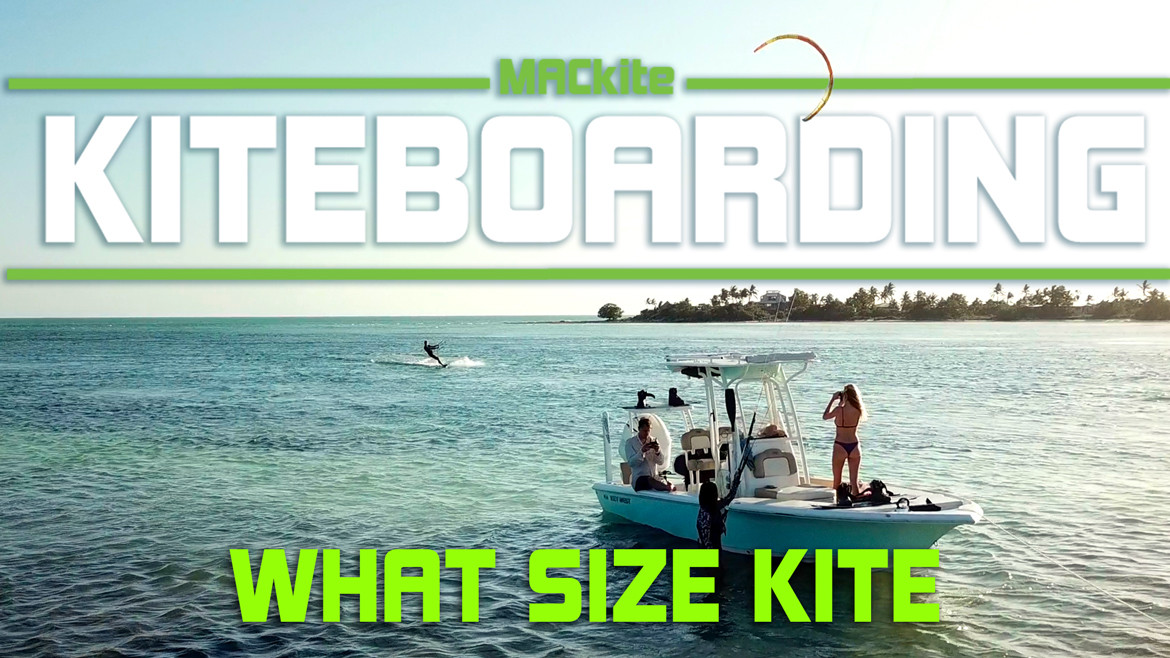How to Choose Your First Kiteboarding Kite Size (With Chart)
This is going to be another quick, information-packed blog. I wanted to cover a question we get almost daily: How do I pick the right size kite? This video is aimed at new riders, but I will address intermediate riders at the end of this blog.
When picking the correct size kiteboarding kite, there are four things to consider:
- How much do you weigh?
- Is this your first kite or are you adding to your quiver?
- What kind of conditions will you be riding in?
- What style of kite are you looking at?

All kiteboarders have a quiver of kites
Starting your quiver
If you're new to kiteboarding and you are looking at your first kite, you'll want to pick a good all-around mid-range kite for your weight, the goal being to maximize your water time in the conditions that you'll be riding in.
When I say mid-range kite, what I mean is that kiteboarders have a quiver of kites:
- Mid-range kite
- High wind kite
- Light wind kite
Why learn on a mid-range kite
For most, the mid- range kite is best for starting. It will be the easiest kite to learn on: not too fast, not too slow, and you'll be using it in the safest wind range for learning.
Eventually, you'll probably want another couple kites, a light wind kite and a high wind kite. The reason most would benefit from starting on a mid-range kite is that these wind ranges take more time to learn. This is because there are different skill sets for different wind ranges.
Your mid-range kite is going to be used at roughly 16 to 21 miles per hour. This is the easiest range for learning kiteboarding. Any less wind, and you can still make great progress flying the kite safely while standing. Once you try getting up on a board, it's going to take a lot more work to learn to ride in light winds. This is because larger kites are less responsive.
If you learn on a light wind kite, there is a benefit from the standpoint of not over-steering the kite. Once you get riding on the water, for someone who is new, it can take more work learning to subtly sine the kite to generate more apparent wind. You have to think two steps ahead when steering your kite to be effective. Launching a kite also takes more skill and practice in lighter winds. If you start with your light wind kite, you'll be spending more time working on this.
In stronger winds, you'll eventually need a high wind kite. If you start on something smaller in stronger winds, things happen a lot faster. Wind tends to be gusty and less consistent. The faster kites are really fun and responsive. You'll often hear that people's favorite size is their 9 or 10 meter. Those of you using this size as your weight-appropriate mid-range kite are lucky because they are the most fun to use.
That said, the smaller the kite and the stronger the wind, the more skill it takes to keep the kite under control.
Need us to pick for you?
Ask in our l ive chat. Tell the crew Rygo sent you!

How long does it take to learn kiteboarding?
The 30 hour rule in kiteboarding
In kiteboarding, we have the 30 hour rule. That is the amount of time it takes to learn how to become an independent kiteboarder. For light winds or strong winds, I would add on another 15 hours of learning time for someone to become efficient. That said, for some, this still might be the best option.
There are some circumstances where you might consider starting with your light or high wind kite. This is where your location comes into play.

Locations like the Florida Keys need a light wind kite
How to pick a mid-range kite by your weight
I've included a kiteboarding size chart that you can reference. The left column is light wind kite recommendations. The center column is mid-range kites and the right is high wind kite recommendations.
Kiteboarding Size Chart

This should give you an idea on the average wind speeds you can ride in and how to choose the right size kite for the conditions. Chose your kite size by the conditions you will be riding in. Build your quiver based on maximizing your water time.
When to consider starting on a different size
Light wind
If you live somewhere that almost exclusively has light winds, you might need to start with a light wind kite. This is usually something three sizes larger than your mid-range and is designed for light winds. A good example would be someone who might weigh 190 pounds and their location only gets wind speeds up to 15 miles per hour on a regular basis. Starting on a 17m kite is going to be the best choice as that's what will get them the most water time.

Kicking it with the Key West crew on a light wind day
High wind
Likewise, if you are primarily riding somewhere with constant strong winds, you'll have to opt for a high wind kite. That same 190 lb. rider living somewhere that consistently gets winds averaging around 25 miles per hour might need a 9 or a 10m.
Admittedly, this is the most difficult wind range to learn in. That said, these locations will often have a decent kite school and top-notch instructors who will get you where you need to be. The conditions might be more difficult, but if it's always windy you'll get more practice than most.
The end goal here is to pick the size you'll be using the most. For most, starting on a mid-range kite is the best choice, even if they might miss out on a few light or high wind sessions. If their riding location demands something different, it's totally fine to go for a light or high wind kite first, just expect to put a little more practice into learning the nuances of those wind ranges.
Rygo riding the slider park in Hood River
Intermediate to advanced level riders
I should point out that in 2020, most kites cater to most levels.
If you are new, stick with All-around kites. At some point, if you become obsessed with a certain discipline like wave riding or wakestyle you can opt for a more specific tool.
Some niche kites are size specific
Sizing gets more specific when looking at niche kites. For example, a wakestyle or freestyle kite may require you to size up. These kites often lack the power or all around kites. Wave kites can also vary. The Cabrinha Drifter is true to size while the Duotone Neo you would size down.
For the sake of clarity and keeping this post shorter I won't go into too much detail on this point. Feel free to reach out if you have any questions!
I hope you found this guide helpful! If you have any questions, follow me and my adventures on instagram. Feel free to shoot me a message. - Rygo
 Ryan (Rygo) Goloversic
Ryan (Rygo) Goloversic
Many people dream of quitting their job, traveling the world and pursuing their passions. Rygo is one of those people who pulled the trigger. A few years into his career, he decided to change everything and travel as a kiteboarder, freelance videographer & writer. His mission is to help people and share the stoke. Get out there and kite!
Rides for:
MACkite Soflo
Producer of: Ride with Blake I Sessions I Versus I Destinations I Foil Fridays
Recent Posts
-
Kiteboarding | Crafting the Harlem Force Kite with Sustainability and Performance
Unparalleled Performance Meets Unmatched Sustainability The kiteboarding industry is on …24th Apr 2024 -
Duotone Ventis 2025 | What's New?
If you're familiar with Duotone's Ventis, you know its specialty is freeriding in light wind …23rd Apr 2024 -
Duotone Ventis D/LAB 2025 Overview
If you ride in an area with multiple light wind days and need a wing that'll let you get o …23rd Apr 2024






